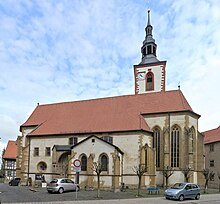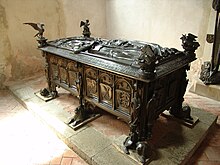Collegiate Church (Römhild)
The collegiate church of Römhild is the Evangelical Lutheran parish church, which is consecrated to the patronage of the Virgin Mary and John the Baptist. Most of it in its present form dates from 1470.
history
The collegiate church was first mentioned in a document in 1341. At the beginning of the 15th century, the Würzburg bishop Römhild approved his own, independent parish. In the middle of the 15th century, the sovereign Count Georg I von Henneberg of the Aschach line, under whose patronage the church stood, created twelve priestly posts for the appointment of canons in order to establish a collegiate foundation together with other wealthy families . In 1450, Bishop Gottfried of Würzburg elevated the church to a collegiate church. As a result, a new hall church was built by 1470. From 1465 the Hennebergers used the church as a court and burial church. The Reformation was introduced in 1546 under the last Henneberg Count of the Aschach line, Count Berthold XVI., Who died in 1549 .
After the first Saxon-Ernestine visitation in 1556, the collegiate monastery was abolished and the collegiate church became the city's main parish church. Duke Johann Casimir had an annex built on the south side of the church in 1585. A city fire in 1609 destroyed parts of the tower head, which had an oak top with a slate roof, and the church roof. The reconstruction from 1610 took place with today's tower dome. At the end of the 17th century, Duke Heinrich arranged for a change in the liturgical orientation, among other things with a new high altar and a new organ .
description
The Römhilder Church still largely has the late Gothic appearance of its completion in 1470. It is a three-aisled staggered hall church with three bays in the nave. The nave of the nave ends in choir rooms on both sides . Rib vaults , resting on high, octagonal pillars, span the nave. There is a large altar in the east choir and a gallery in the west choir , which was originally the place of the prince's chair and has been carrying the organ since 1680. The entrance hall of the western church portal is on the ground floor. A stone inscription above this testifies to the construction of the church and the foundation. The church tower, which is around 48 meters high, stands at the end of the north aisle next to the east choir. At the top it has a hood with a double, slate arcade top and a Welsch hood as well as a tower ornament with a tower button and a weather vane. Four bronze bells, the oldest from 1610, hang in the tower. In the basement of the tower is the sacristy, which also has a rib vault.
In 1965, parts of the neo-Gothic galleries and stalls as well as the pulpit were removed as part of a renovation. The colored version from the 15th century has been reconstructed.
Furnishing
The baroque organ was built between 1680 and 1682 by the Gotha organ builder Johann Moritz Weisse with 25 stops , two manual works and a pedal . The Römhild court carpenter Esajas Sterzing created the prospectus . The Schleusinger organ builder Theodor Kühn rebuilt the instrument in 1866 and removed the Rückpositiv . In 1980 the Bautzner organ building workshop Eule carried out a restoration whereby the original condition was largely restored.
In the east choir is a Baroque high altar from 1692, carved by Johann Adam Lux from Neustadt an der Saale and painted by the court painter J. Gedeler from Bayreuth. In the center of the altar shows the baptism of Jesus by John the Baptist and the open sky with the dove. Below is a verse from Psalm 111.4. Above it, the group of disciples is shown with Jesus in their midst. The upper end is a figure of Christ as the risen Lord with the victory flag. The four evangelists with their symbols are arranged to the side of the representations. There are also stone tombstones of the Counts of Henneberg in the east choir, choir stalls from the time of the Canons' monastery, as well as panel and glass paintings from the time the church was founded.
The bronze grave monuments of the Counts of Henneberg, which came from the workshop of the Nuremberg ore caster Peter Vischer the Elder and his sons, are among the special pieces of equipment . The monuments were created between 1488 and 1510 and have been in the baptistery since 1735. There is a statue of Otto IV von Henneberg and the tumba for Hermann VIII von Henneberg and his wife Elisabeth von Brandenburg , a work from the early Renaissance period that bears a total of 16 coats of arms.
A library was built while the monastery was in existence. The historical church library today comprises 846 titles, 196 of which were published in the 16th century.
literature
- Joachim Neubert, Günter Stammberger, Bernhard Grossmann, Martin Hoffmann: The churches in the district Hildburghausen ... none other than the house of God - the gate of heaven ... . Verlag Frankenschwelle, Hildburghausen 2006, ISBN 3-86180-174-4 , p. 218.
Web links
Individual evidence
Coordinates: 50 ° 23 ′ 51.8 ″ N , 10 ° 32 ′ 20.8 ″ E



